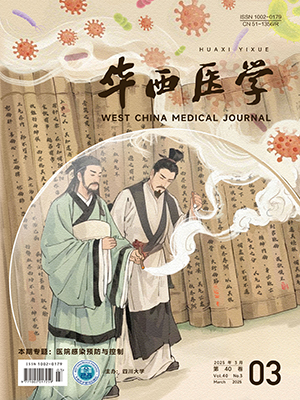Objective To explore the prognostic risk factors of bloodstream infections caused by Acinetobacter baumannii in the hospital, to provide a basis for clinical diagnosis and treatment.Methods A retrospective analysis was performed on the medical records of patients diagnosed with Acinetobacter baumannii bloodstream infection in Guangxi Zhuang Autonomous Region People’s Hospital between January 2013 and December 2018. The patients were divided into survival group and non-survival group according to the outcome within 30 days after blood culture was collected. Univariate and multivariate logistic analyses were used to identify the risk factors of Acinetobacter baumannii bloodstream infections.Results A total of 123 patients were included, including 48 in the survival group and 75 in the non-survival group. Third generation cephalosporins [odds ratio (OR)=2.492, 95% confidence interval (CI) (2.125, 2.924), P<0.001], carbapenems [OR=1.721, 95%CI (1.505, 1.969), P<0.001], multidrug resistant-Acinetobacter baumannii infection [OR=1.240, 95%CI (1.063, 1.446), P=0.006], post-operation [OR=0.515, 95%CI (0.449, 0.590), P<0.001], mechanical ventilation [OR=1.182, 95%CI (1.005, 1.388), P=0.043], indwelling central venous catheter [OR=0.116, 95%CI (0.080, 0.169), P<0.001], mixed infection or septic shock [OR=3.935, 95%CI (2.740, 5.650), P<0.001], APACHE Ⅱ score (≥15) [OR=5.939, 95%CI (5.029, 7.013), P<0.001], chronic kidney disease [OR=1.440, 95%CI (1.247, 1.662), P<0.001], immune system disease [OR=28.620, 95%CI (17.087, 47.937), P<0.001], use of corticosteroids [OR=0.520, 95%CI (0.427, 0.635), P<0.001], and combined antifungal agents [OR=0.814, 95%CI (0.668, 0.992), P=0.041] were independent factors for predicting the prognosis of patients with bloodstream infections caused by Acinetobacter baumannii.Conclusions The third generation cephalosporins, carbapenem, MDR-Acinetobacter baumannii infection, post-operation, mechanical ventilation, indwelling central venous catheter, mixed infection or septic shock, APACHE Ⅱ score (≥15), chronic kidney disease, immune system disease, use of corticosteroids, and combined antifungal agents were independent factors for predicting the prognosis of patients with bloodstream infections caused by Acinetobacter baumannii. In the clinical work, it is needed to carry out timely detection of microbial etiology, timely report, and reasonable treatment.
Citation:
LIANG Liang, LIU Xiaochun, CHEN Xingchun, ZHAO Li, PANG Guangbao, HE Yi, TANG Juan, ZHOU Xiangyang. Prognostic risk factors associated with bloodstream infections caused by Acinetobacter baumannii. West China Medical Journal, 2021, 36(1): 76-81. doi: 10.7507/1002-0179.201911221
Copy
Copyright © the editorial department of West China Medical Journal of West China Medical Publisher. All rights reserved




